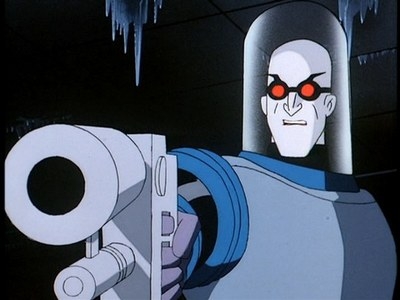
Putting the “Science” in “Science Fiction” – Mr. Freeze
Mr. Freeze is a popular villain from the Batman series, known as much for his tragic back story as his ice-based weaponry. Like many comic book characters, many changes to his origins have evolved over time but the best-loved version is that he was originally a cryogenic researcher named Victor Fries who was forced to place his wife in suspended animation while he worked on a cure for her fatal disease. Fries was later exposed to cryogenic chemicals that mutated his body to rely on subzero temperatures, forcing him to wear a refrigerated suit to survive.

In order to finance his research into curing his wife’s condition, the scientist adopted the name Mr. Freeze and turned to a life of crime, using a variety of high-tech devices that could manipulate cold. In particular, the villain relied on a gun that could freeze his targets solid, though without permanently harming people if they were thawed out in time. Although freeze guns and refrigerated suits are elements of science-fiction, the field of cryonics is a focus of a great deal of study, due to its potential to preserve lives.
The main idea behind cryonics is that, by freezing the remains of people who have died very recently, their bodies and minds can be preserved, allowing the condition that caused their death to be reversed in the future. The main idea that this practice centers on is that an individual’s personality and intelligence are encoded into cells in the brain and thus a personality can survive a long pause in brain activity as long as no cell damage occurs. Although this is simple in theory, serious issues must be solved before the technology can be used reliably.
One problem with cryonics is the response cells have to being frozen. When cells are frozen, the water in or surrounding these cells can freeze, causing potentially catastrophic damage. This issue can be solved by replacing the water in the cells with fluids known as cryoprotectants, which resist crystallization at freezing temperatures. Although this helps solve the problem of cell damage, the cryoprotectants are in themselves toxic, but exactly how this toxicity affects the body is not currently understood. Another issue is that cryonics is practiced after a person is declared legally dead. The delay between legal death and cryonic preservation can range from mere seconds to hours, and this – combined with the necessity of adding cryoprotectants to replace body fluids – can lead to damage to the body through oxygen and nutrient deprivation. The brain is especially

susceptible to this type of damage and it is for this reason that most cryopreservation is performed on small clusters of cells, such as DNA samples, sperm, eggs and fertilized embryos. Small groups of cells require less of the toxic cryoprotectants, can be frozen more quickly, and are much less susceptible to damage than larger organs or entire bodies. Although there are many potential sources of damage, the assumption of researchers working in the cryonics field is that future technology will allow the potential health problems of cryonic freezing to be addressed.
How exactly to revive people who were cryogenically frozen is another important issue, as the reviving process must address the potential hazards of cryogenic freezing and the condition that caused the person to die and be frozen in the first place. Another major problem with reviving cryonic patients is that the most effective and cheapest method of cryonic preservation is neuropreservation – the preservation of only the brain or head. This method is much cheaper, since a smaller amount of coolant and storage space are needed, and is considered safer and more effective, as less cryoprotectant is required and freezing temperatures can be reached more quickly. The problem is that once a person is revived, they will require a new body to use in order to survive. These issues have not yet been addressed, and present major obstacles to the idea of cryonic preservation.
Another issue is that cryonic technology and practices have steadily become more effective and sophisticated, which means that people who were cryogenically preserved earlier will be more difficult to revive, if revival is possible at all. This creates what some people call the “last-in-first-out” problem, where the most recently preserved people are the first to be brought out of suspended animation. This is linked to the problem of expense, as cryogenic preservation is very costly, and becomes more expensive the longer someone has to remain frozen. Although cryogenic technology will continue to improve and become cheaper and more effective, advances in medical technology that allow people to be easily revived will be necessary before the technology becomes truly feasible.

Even though there are many problems with cryonic freezing, the technology offers huge potential benefits. Once it becomes possible to freeze and revive people safely and with no long-term effects in an affordable manner, cryonics will likely become a common treatment method. It could someday be possible to cryogenically freeze injured or sick people to ensure they are safely transported to a treatment center, or to provide time for an organ transplant donor to be found. It might even be possible to freeze healthy people into a state of suspended animation, as is shown in many science-fiction stories of interstellar travel, in order to allow them to survive a long journey through space and then be revived at their destination.
TOP PHOTO: technorati.com









